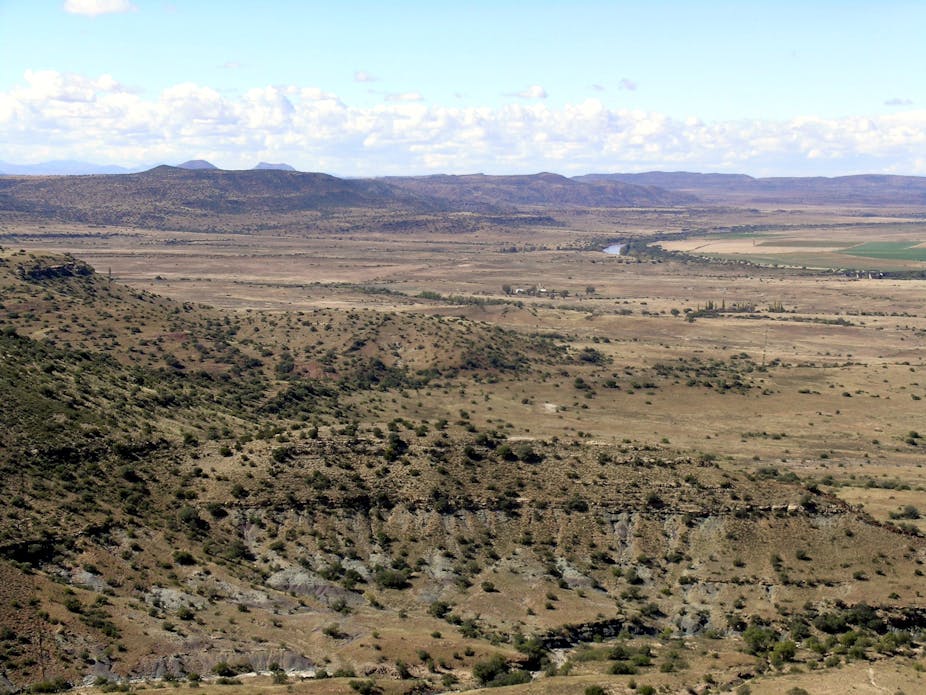More than 250 million years ago, something huge happened to the Earth: the Permo-Triassic Mass Extinction (PTME), which wiped out almost all of the planet’s species. Now a group of scientists has uncovered important details about how the event’s survivors adapted in a harsh, drought-stricken stretch of South Africa. The Conversation Africa’s science and technology editor Natasha Joseph asked lead researcher Dr Jennifer Botha-Brink to explain what she and her colleagues have learnt – and what this might teach us about species’ adaptation to climate change.
Lots of research has been done about this period and its impact. What was your research trying to understand, specifically?
There have been five major mass extinctions in Earth’s history and the PTME was by far the most catastrophic, killing 70% of all terrestrial species and somewhere between 80% and 96% of all marine species. The environment changed from a world with abundant vegetation, large meandering rivers and a temperate climate to a highly seasonal, drought-stricken, unpredictable environment. The world’s ecosystems did not fully recover until some five million years after the extinction event.
The aim of our research was to discover the changes, if any, that occurred in vertebrate life histories across the PTME. In other words, how did the survivors adapt to the harsh, unpredictable, drought-stricken post-extinction environment? To try and answer this question, we compared the growth patterns of Permian (pre-extinction) and Triassic (post-extinction) therapsids – they were the ancient ancestors of mammals – by looking at their bone microstructure.
The bone microstructure, or histology, of extinct vertebrates gives a unique view on how they lived. It provides information about how quickly an animal grew, the manner in which it grew, when it matured – that’s the age it was at skeletal and possibly reproductive maturity – and how old it was when it died. This information allows us to reconstruct the animal’s life history.
Comparing the life histories of therapsids that lived before and after the extinction allowed us to identify differences in the Early Triassic animals that may have helped them survive the PTME. Our results help explain how some species that thrive in post-extinction environments, such as the therapsid Lystrosaurus, not only survived but spread to all areas of the globe and became the most abundant vertebrate after the PTME.
Your research was focused on therapsids that had occurred in South Africa’s Karoo Basin. How large an area is that, and why did you choose it as the site for your work?
The South African Karoo Basin contains the best, most complete terrestrial record of the PTME. It covers some 730,000km² of the interior of South Africa. Thousands of therapsid fossils have been found in these strata, providing a complete fossil record through the Permo-Triassic boundary. There was enough material from many different therapsid species to allow us to obtain the information required for this type of analysis. It is the best place for studying the PTME and its influence on animal and plant life histories.

How did you extract the data you needed? And what was it you were looking for in those fossils – what stories did they tell you?
Our analysis focused on fossil bone microstructure and body size measurements. Limb bones were sectioned using specialised cutting and grinding equipment. Thin slivers of the fossil bone were then fixed to glass slides and examined under a microscope. Although the organic components of the bone have long since disappeared, the orientation of the bone tissue fibres, the spaces for marrow, blood vessels and bone cells remain intact. This allows us to compare growth patterns and rates between different species.
We also obtained body size data by measuring the skull lengths of as many therapsid specimens as possible. These measurements were used to compile body size distributions so we could compare the demographics between Permian and Triassic therapsid species. All the data were then combined to assess the ecology of Permian and Triassic therapsids.

We also used the data to create a theoretical model showing what kind of features would have helped the post-extinction therapsids to survive. The bone microstructure and body size data showed that Early Triassic therapsids grew quickly to skeletal and reproductive maturity and then died at young ages. The simulations of population growth supported our results by showing that reproducing at young ages would indeed have helped the survivors to persist in the harsh, unpredictable post-extinction environment.
Your work focused on extinct species. What are its applications today? What can it tell us about how species might cope with another big “die-out”?
Research on past extinctions provides data on how ecosystems change in response to severe climate change. It also shows how species adapt to their new environment. This information can be applied to today’s world, which is currently in the midst of a sixth mass extinction.
We can use information from the past to predict which species might survive and which may be more sensitive to extinction. In this way we can learn how to conserve susceptible species such as those that take many years to reach adulthood. Those that take longer to breed or have few young may be more likely to become extinct than those that breed when they are still young and have many babies.

